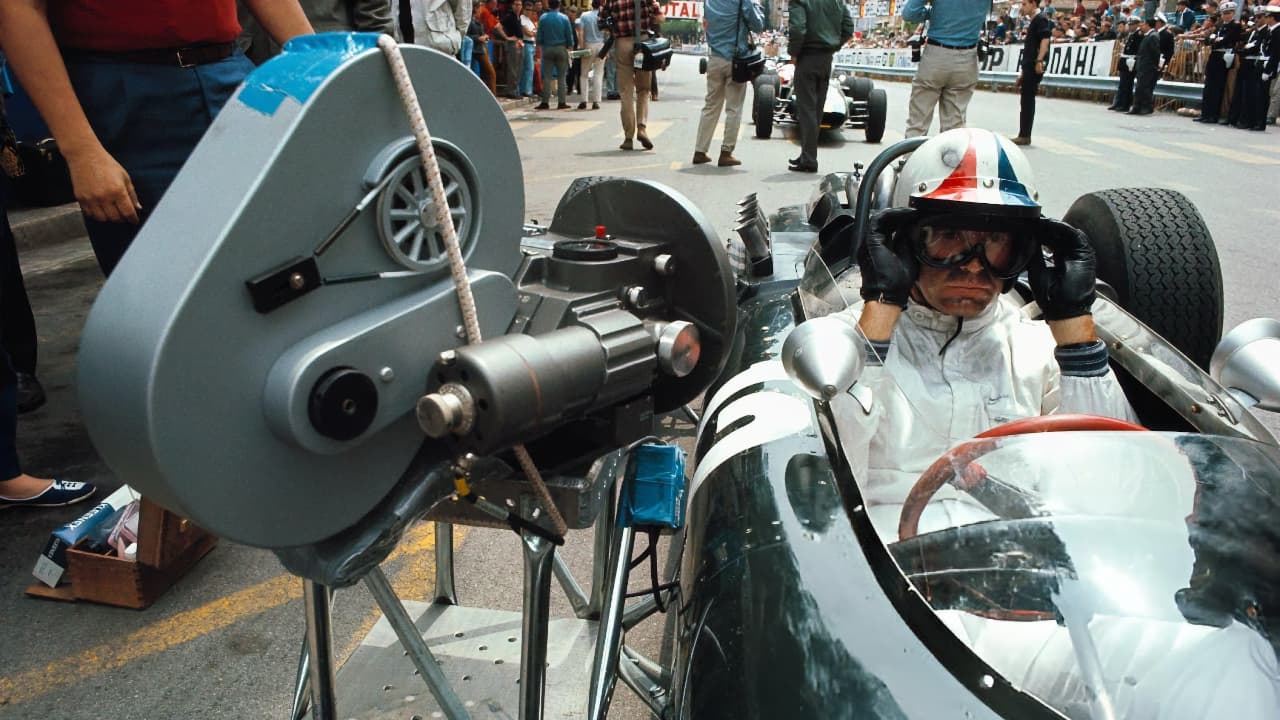
F1: The Movie’s on-track action sequences were captured with a mix of custom Sony and Apple technology, the latest developments in a history of onboard filming that goes back 76 years.
If you wanted to create an environment that is going to be as hostile as possible for a camera, then a Formula One car is probably a good start. The G-forces and the vibration combine to make it a huge challenge for any electronic devices, and we can only imagine how many analog devices from yesteryear got shaken to bits while trying to capture footage of the drivers wrestling their machines round the world’s circuits.
F1 celebrated its 75th anniversary last year and, thanks to a combination of commercially minded ownership in the shape of Liberty Media, Netflix’s yearly Drive to Survive combination reality show and soap opera, and now Apple’s huge and successful punt on remaking Top Gun with cars, F1: The Movie, the sport is as high profile as it’s ever been.
And part of the reason for its recent success is that we can get into the cockpit nowadays. The live TV broadcast can take footage from onboard cameras mounted at multiple points on all the cars and even get a driver’s eye view from inside the helmet. But while all this is comparatively new, F1 has always known that capturing the sound and fury of the cars from a driver’s perspective has been the best way of selling the excitement of the formula. And before live video, there was film…
1966 and all that

Pic: Rainer Schlegelmilch via MGM Studios
76 years of Formula One is also 76 years of attempting to capture it. In the 1950s and all the way up to the digital era, this meant mounting film cameras on scaffolds and bolting them onto the cars. 16mm cameras were used because they were smaller and lighter, but even then once they’d been added to a bunch of metal tubes and welded onto the chassis, you didn’t have anything you could race with. Footage from the era is invariably from practice or closed sessions.
The 1966 film Grand Prix was the start of a step change as it showcased what could be done to the F1 community as well as a wider audience. Director John Frankenheimer filmed American driver Phill Hill driving specially adapted camera cars at Monaco and Spa. And there was no half-hearted reliance on 16mm, the movie being shot on Super Panavision 70.
Anyone wanting a detailed look at all this is directed to motor sport site Divebomb’s excellent detailed article on the subject.
1990s: Going live
The prospect of live video links, of course, changed everything. Various experiments were conducted through the course of the 1980s with video cameras, but even though the first images were captured as far back as 1985, the technology was still cumbersome, heavy, and unreliable.

The T-Cam is clearly visible on the airbox of Michael Schumacher's Ferrari in 2008. Pic: dreamstime.com
This started changing rapidly as the 1990s dawned, resulting in some astonishing onboard footage such as this 1990 Monaco lap from the great Ayrton Senna. It wasn’t until towards the end of the decade though that the iconic T-Cams were introduced. These were aerodynamic units that sat on top of the airbox. Not all cars ran them initially, so dummy units of exactly the same weight were mounted to the rest of the cars in order that the aero and weight penalties were the same for all.
This effort coincided with the introduction of F1 Digital+. Bernie Ecclestone’s Formula One Management company was an early first mover in digital broadcasting, pioneering a flypack production facility that would be airfreighted along with the teams and cars around the world. The onboard footage was an important part of the service, FOM restricting what it shared with the broadcasters in the hope of obtaining direct subscribers. So, while by the early 2000s every car was capable of transmitting live footage, not many people were seeing it.
2004: FOM takes control
Anyone who watched F1 in the earlier days will remember the frustration of a TV director following the car of the host Grand Prix nation’s favourite son round the track at the back of the field while all manner of actual exciting racing action took place unseen in front of him. The quality of the coverage was widely variable as a result, and FOM took matters into its own hands by starting to produce the World Feed itself from 2004 onwards. By 2012 only the Monaco GP was being produced by the local broadcaster, by 2023 none of them were.
This centralisation has not only resulted in better coverage it’s also enabled FOM to invest in more and more camera technology that it also now makes available to broadcasters round the world. Have a look at the footage below that contrasts Ayrton Senna’s 1990 Monaco pole position lap with Lewis Hamilton’s 2019 one. It’s not just that the cars are faster but the coverage is dramatically different too.
And things are still evolving on the broadcast side. The Driver’s Eye viewpoint is now provided by a tiny 2.5 gram unit that sits between the lining and the shell of a driver’s helmet, the Gyro Cam that debuted last year is making its way into the live feed more and more, and stabilised helicopter tracking shots and static tethered drones are providing new dimensions to the aerial components of the race coverage.
But we’ll finish where we started, with capturing F1 on film.
F1 goes back to the movies
For F1: The Movie, cinematographer Claudio Miranda, ASC said what he wanted was pretty much a sensor on a stick. Alongside that though, “We still wanted to have shallow depth of field and full frame and strive for filmic images,” he says, which is where Sony came in.
The company supplied 25 bespoke cameras to the production, essentially a decoupled version of the sensor used in the FX6 (and if that seems a lot there were up to 16 mounting positions on the adapted F2 cars that were used for filming the race sequences). These could pan at speed — certainly faster than the panning moves you see on live broadcasts from Indycar, for instance — and also had a focus motor attached to them to get that proper cinematic output. Inevitably, the sensors had to be separated from the recording units, which were crammed into the chassis of the cars as best as possible.
Then, in a separate effort, the standard broadcast modules that show the track ahead with the driver’s head in the frame were taken by Apple engineers and filled with new components to deliver film resolution material that could be intercut with the Sony originated scenes. This new unit was constructed around the A17 Pro chip and 48-megapixel primary camera found in the iPhone 15 Pro. As Wired reports, it also contained an iPhone battery and an ND filter over the camera, while video was captured with Apple's ProRes lossless video codec.
Custom firmware had to be developed for the effort which brings us to a nice little coda for the whole story of capturing F1. One of the rationales for car makers to get involved with the huge expense of running a Formula One team has always been that the R&D needed to be successful in F1 always trickles through to the road user. Now, it seems, we have the camera version. The custom firmware developed for the iPhone cameras led to log encoding and support for the Academy Color Encoding System (ACES) color workflow in the iPhone 15 Pro, while the Sony system used in the cars is remarkably similar to the Venice Extension System Mini released earlier this year.
tl;dr
- The on-track action in F1: The Movie utilized advanced Sony and Apple technology, continuing a nearly 75-year tradition of capturing onboard racing footage despite the challenges posed by extreme G-forces and vibrations in Formula One cars.
- The celebration of F1's 75th anniversary has heightened the sport's visibility, aided by Liberty Media's ownership, Netflix’s Drive to Survive series, and Apple’s investment in F1: The Movie, enhancing the excitement around the formula.
- From the 1950s to the digital era, capturing F1 footage evolved from using 16mm film cameras mounted on cars to the significant advancements showcased in the 1966 film Grand Prix, which utilized Super Panavision 70 technology.
- The introduction of live video coverage in the 1990s, including the iconic T-Cams and FOM's centralized production of the World Feed since 2004, drastically improved broadcast quality and availability of onboard footage, leading to continuous advancements in camera technology.


Comments